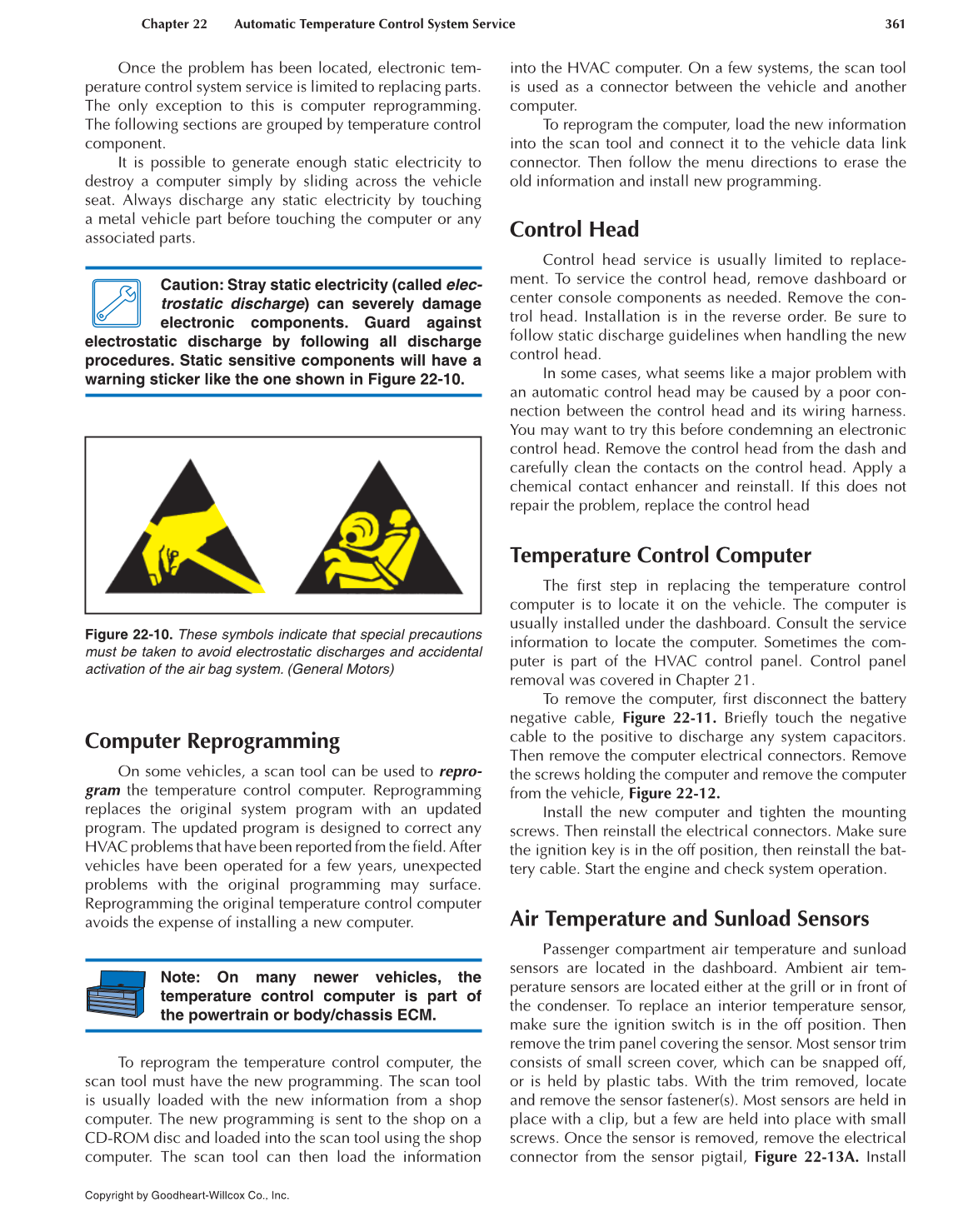Chapter 22 Automatic Temperature Control System Service 361
Copyright by Goodheart-Willcox Co., Inc.
Once the problem has been located, electronic tem-
perature control system service is limited to replacing parts.
The only exception to this is computer reprogramming.
The following sections are grouped by temperature control
component.
It is possible to generate enough static electricity to
destroy a computer simply by sliding across the vehicle
seat. Always discharge any static electricity by touching
a metal vehicle part before touching the computer or any
associated parts.
Caution: Stray static electricity (called elec-
trostatic discharge) can severely damage
electronic components. Guard against
electrostatic discharge by following all discharge
procedures. Static sensitive components will have a
warning sticker like the one shown in Figure 22-10.
Computer Reprogramming
On some vehicles, a scan tool can be used to repro-
gram the temperature control computer. Reprogramming
replaces the original system program with an updated
program. The updated program is designed to correct any
HVAC problems that have been reported from the fi eld. After
vehicles have been operated for a few years, unexpected
problems with the original programming may surface.
Reprogramming the original temperature control computer
avoids the expense of installing a new computer.
Note: On many newer vehicles, the
temperature control computer is part of
the powertrain or body/chassis ECM.
To reprogram the temperature control computer, the
scan tool must have the new programming. The scan tool
is usually loaded with the new information from a shop
computer. The new programming is sent to the shop on a
CD-ROM disc and loaded into the scan tool using the shop
computer. The scan tool can then load the information
into the HVAC computer. On a few systems, the scan tool
is used as a connector between the vehicle and another
computer.
To reprogram the computer, load the new information
into the scan tool and connect it to the vehicle data link
connector. Then follow the menu directions to erase the
old information and install new programming.
Control Head
Control head service is usually limited to replace-
ment. To service the control head, remove dashboard or
center console components as needed. Remove the con-
trol head. Installation is in the reverse order. Be sure to
follow static discharge guidelines when handling the new
control head.
In some cases, what seems like a major problem with
an automatic control head may be caused by a poor con-
nection between the control head and its wiring harness.
You may want to try this before condemning an electronic
control head. Remove the control head from the dash and
carefully clean the contacts on the control head. Apply a
chemical contact enhancer and reinstall. If this does not
repair the problem, replace the control head
Temperature Control Computer
The fi rst step in replacing the temperature control
computer is to locate it on the vehicle. The computer is
usually installed under the dashboard. Consult the service
information to locate the computer. Sometimes the com-
puter is part of the HVAC control panel. Control panel
removal was covered in Chapter 21.
To remove the computer, fi rst disconnect the battery
negative cable, Figure 22-11. Briefl y touch the negative
cable to the positive to discharge any system capacitors.
Then remove the computer electrical connectors. Remove
the screws holding the computer and remove the com puter
from the vehicle, Figure 22-12.
Install the new computer and tighten the mounting
screws. Then reinstall the electrical connectors. Make sure
the ignition key is in the off position, then reinstall the bat-
tery cable. Start the engine and check system operation.
Air Temperature and Sunload Sensors
Passenger compartment air temperature and sunload
sensors are located in the dashboard. Ambient air tem-
perature sensors are located either at the grill or in front of
the condenser. To replace an interior temperature sensor,
make sure the ignition switch is in the off position. Then
remove the trim panel covering the sensor. Most sensor trim
consists of small screen cover, which can be snapped off,
or is held by plastic tabs. With the trim removed, locate
and remove the sensor fastener(s). Most sensors are held in
place with a clip, but a few are held into place with small
screws. Once the sensor is removed, remove the electrical
connector from the sensor pigtail, Figure 22-13A. Install
Figure 22-10. These symbols indicate that special precautions
must be taken to avoid electrostatic discharges and accidental
activation of the air bag system. (General Motors)
